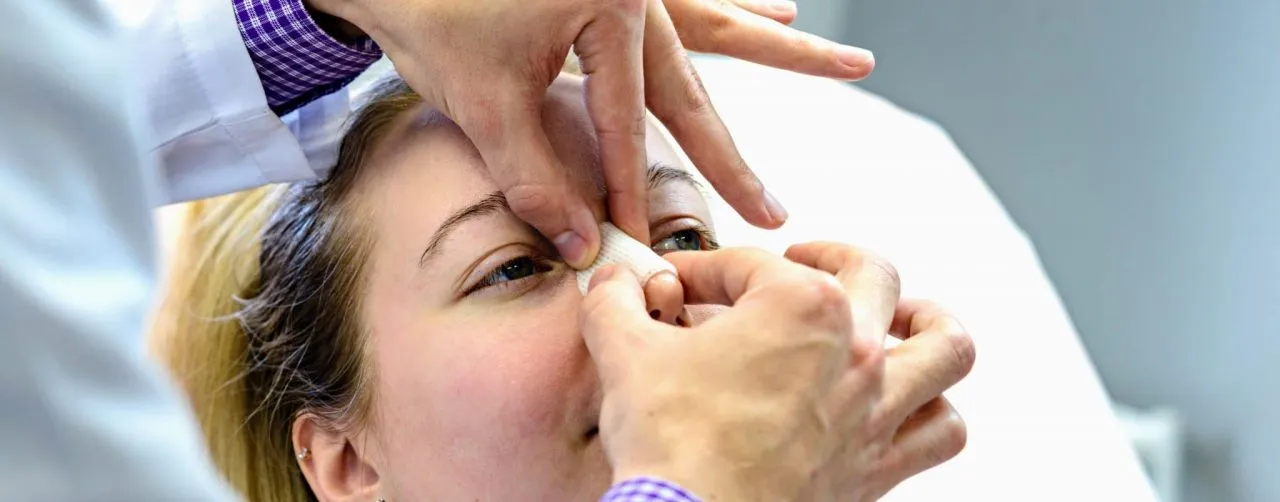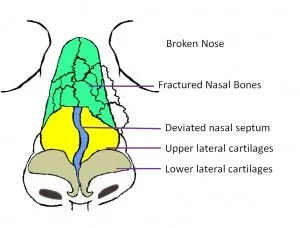
A broken nose, also known as a nasal fracture, is when an injury results in damage to any of the structures that serves as the architecture of the nose. Both the external and internal parts of your nose are made up bone and cartilage. The bones are at the head, or top of the nose and help form the pyramidal bridge shape of your nose that starts between the eyes. The remaining middle and lower part of your nose consists of cartilage. If one or both of these elements are damaged or dislocated, it may results in a nasal fracture or broken nose.

A comprehensive medical history and physical exam with close examination of the outside and inside of your nose is undertaken to properly diagnose any issues with your nose. Furthermore, to properly identify any issues with the back of your nose that cannot be seen easily with the naked eye, a small endoscope is used to properly visualize the entire septum, front to back, to identify any hidden abnormalities. X-rays and other imaging exams are typically unnecessary. Nevertheless, a computerized tomography (CT) scan may be pursued if the extent of your injuries are severe enough so that they make a thorough physical exam difficult or if there is a suspicion for other injuries. It is not uncommon for patients to already have a CT scan done at a hospital emergency room and present to a nose specialist with a report already showing a diagnosed nasal fracture.
Dr. Harounian is an expert in all forms of nasal surgery and has extensive experience with many conditions regarding the nose. Furthermore, he has wide fund of knowledge with regards to other causes of nasal obstruction and will be able to not only diagnose and effectively treated any issues with your broken nose, but also diagnose and address any other causes of nasal blockage as well.

The first thing not to do is try to fix your broken nose. What may look superficially as a simple break on the outside of your nose may in reality be a more serious and complex injury that requires further workup. Furthermore, you may damage your nose even further. Immediately after your injury, you should apply ice or an ice compress to the injured area to help keep the swelling down. It is important to only use light pressure to keep the ice down on your nose as you may dislocate or damage the nose further if you press firmly. In addition, over-the-counter medications such as Tylenol, or acetaminophen, and non-steroidal anti-inflammatory medications such as Advil, or ibuprofen, may relieve pain and help reduce inflammation. If possible, it is best to use acetaminophen and not on-steroidal anti-inflammatory medications such as Advil, or ibuprofen, because the latter thins your blood and may cause further nasal bleeding.

Treatment for a broken nose, or nasal fracture, varies on the extent and severity of the injury. If there is no clinically visible change in the appearance of the nose and there are no function issues with nasal breathing, then mild nasal fractures can simply be observed without undergoing any type of procedure. Beyond this, surgery is typically required to repair a broken nose.

Closed reduction – A closed reduction of a broken nose refers to the physical reduction of a broken nose via manual pressure placed both internally and externally. This can occur in various settings such as the office, emergency room, or operating room with either local or general anesthesia. The goal is to use internal and external pressure to manually re-position and re-align the broken nasal element to their pre-injury position. This procedure, the closed reduction, is performed and most successful within the first 7-10 days of the injury onset and if the nasal fracture is simple and not extensive. This is because within this time, the fractured bones are still mobile enough to allow for re-alignment to their natural position via manual pressure. After this time period, the nasal bones have begun to form thick fibrous tissue and calluses and fuse. This makes manual reduction of the fractured elements significantly difficult and exponentially reduces the success rate. After this time, you may not be a candidate for closed reduction but you are a candidate for open reduction.
Open reduction – Open reduction refers to the re-shaping of the nose after nasal injury. This occurs via specific tools that are used to form controlled, meticulous cuts in the base of the nasal bone so as to re-align your nose and restore it back to its natural, pre-injury position. This usually occurs in an operating room setting with general anesthesia. Open reduction is typically reserved for complex fractures that involve multiple broken elements of your nose and/or patients with fractures who present after 7-10 days. Furthermore, patients who have had a closed reduction with unsatisfactory results also are candidates for open reduction via rhinoplasty approach, which can occur months after the procedure. Additionally, if rhinoplasty is undertaken to reduce your nasal fractures, you can also include other features of your nose to modify as well in conjunction with the reduction.
Combined with a Septoplasty -If your septum has been deviated or broken because of the injury, a septoplasty to correct it can be undertaken at the same time the rhinoplasty is performed.

Prior to surgery, you will have to refrain from any smoking in addition to any medications that can thin your blood as well as any supplements such as vitamin E, garlic, gingko, ginseng, ginger, saw palmetto, and fish oil. You will need to have someone accompany you after surgery. We understand that the idea of surgery is a heavy one to consider and can be daunting. Dr. Harounian takes every measure to assure that you feel comfortable and informed of the entire process and including the surgery before you leave the office and enter the operating room. He will meet with you for as long as you need and as many times as you wish. He will often welcome family members as well to have a group discussion to make sure everyone is on the same page. You will receive a handout detailing everything that is discussed beginning with what to do the day before your surgery to what you should be doing after your surgery and for the week following your surgery as well. You will receive a personalized bag with supplies that you will need for your aftercare.

Broken nose surgery is typically a same-day outpatient procedure that takes approximately 1-2 hours depending on the extent and severity of the condition. The surgery mainly consists of three parts:
Anesthesia – Typically general anesthesia is used so that you are asleep and comfortable during the surgery.
Reduction surgery – During the surgery, special tools are used to re-shape the nasal bones, remove any deviated tissue such septum, and open up the inside of your nose. This will re-align your nasal bones so as to restore your natural appearance and optimize your nasal breathing.
Bandaging/dressing – You may have some packing/bandages and sutures on either the inside or outside of the nose depending on the extent of the surgery.

There are a variety of risks associated with repairing a broken nose.
Fortunately, these risks are rare but it is important to be informed of any possible risks. Dr. Harounian has extensive training with nasal surgery and takes every care to optimize your results.

As broken nose surgery is an outpatient procedure, you will go home the same day. You may feel some soreness and notice some bruising in addition to mild swelling on your nose for a couple of weeks. During this time, it may be difficult or uncomfortable to breathe through one or both sides of your nose as healing continues and the swelling subsides. You may have other types of surgery in conjunction with your procedure as well. Depending on the additional procedures, the recovery time may be shorter or less. Dr. Harounian rarely needs to use packing inside the nose after surgery and patients can generally breathe through the nose very soon afterward. In most cases, you will be able to go back to work within the first week but avoid any physical exertion or heavy exercise for 2 to 3 weeks. Most patients fully recover within a month.

Fortunately, nasal surgeries such as broken nose surgery that are meant to improve the breathing function of your nose are typically covered by most insurances. Dr. Harounian is a strong believer in making sure his patients are always informed throughout the entire process starting from diagnosis to treatment. His office will perform a full check of your insurance plans and inform you well ahead of time of any financial responsibilities that you may have. We help you avoid surprises and all efforts are taken to not only meet, but exceed your goals and expectations.

A broken nose can be very upsetting for you to look at and may decrease your quality of life due to a decreased ability to breathe. Dr. Harounian will discuss all the options for treatment with you and help you chose the optimal management. Dr. Harounian is an expert at all forms of facial and nasal surgery. If you would like help with your broken nose please feel free to contact us.